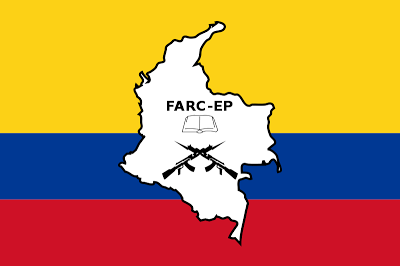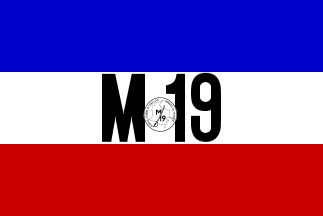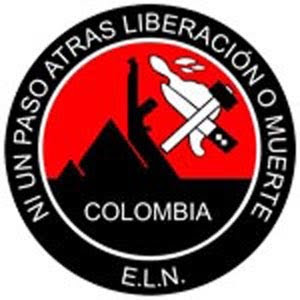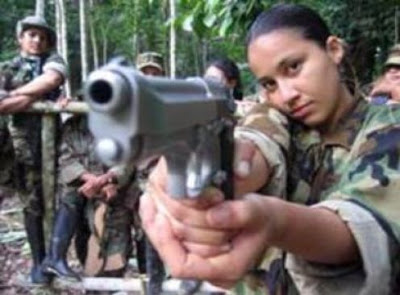“Por la nueva Colombia, la patria grande y socialismo.”(“For the new Colombia, the greater fatherland, and socialism.”) — FARC motto. Photo from HubPages.
Armed struggle for land reform and justice:
Fuerzas Armadas Revolucionarias de Colombia
By Marion Delgado / The Rag Blog / December 30, 2009
CARTAGENA DE INDIES, Colombia — In May 2003 a leak from the Bush Treasury Department indicated that the Office of Foreign Assets Control (OFAC) was about to add to its extensive narcotics traffickers list. This time it would add someone in Colombia.
OFAC would be using one of the enlightened Republican Congress’s new drug war laws, the Foreign Narcotics Kingpin Designation Act. I was pretty sure who the new addition would be. The word “kingpin” was a dead giveaway.
It had to be the guy who had attained high office; whose brother had organized 20 or more death squads and maintained a couple of them out at the family hacienda; whose cousin in the Colombian Congress was the mouthpiece for those death squads as well as a close friend and promoter of various well known narcotrafficantes, including the legendary Pablo Escobar; someone whose own father was wanted by the Colombian police and the U.S. DEA for cocaine trafficking when he was killed in an abortive kidnap plot; and who himself was removed from his position as mayor of Medellín for having well-known ties to drug runners.
Who else could it be, but master criminal and El Presidente himself, Alvaro Uribe?
Imagine my surprise when it was announced the next day, that it was not Uribe after all, but the Revolutionary Armed Forces of Colombia — Peoples Army (FARC or FARC-EP) and 15 of their known or suspected leaders, even though I already knew they had to be a bad bunch of hombres. Five years before, in 1997, they were named a Foreign Terrorist Organization by the U.S. Department of State.
It couldn’t have been easy to make it to the top of two government lists at the same time (the terrorist list and the narcotrafficantes list) and be the defining designees of a whole new hyphenated word, “Narco-terrorist”! That should keep them from gaining credibility with anyone with media access in the U.S.! I started wondering who these FARC guys were. Somebody needed to check them out, find out where they came from, and why.
The roots of FARC-EP
The current civil war in Colombia has been characterized by gross human rights violations, increasing dramatically over the past two decades. International human rights organizations have repeatedly singled out right-wing paramilitary groups (paracos) as being the principal perpetrators of human rights abuses.
The paracos are intertwined with the Colombian Armed Forces as they wage war against, not only the guerrillas, but anyone suspected of being a guerrilla sympathizer: union members, peasant organizers, human rights workers, and religious activists. Some paracos leaders have extended the parameters of the war against the guerrillas and their suspected fellow travelers to include drug addicts, alcoholics, prostitutes, petty criminals, and the homeless, in an attempt to “cleanse” Colombian society. Social cleansing is different from ethnic cleansing only in the presumed reasoning, it has the same results.
Over the years, several Colombian presidents have attempted to address the social, political, and economic injustices that are the principal causes of the conflict. However, these efforts have been repeatedly thwarted by the U.S. and its war on drugs, and by the Colombian political, economic, military elite, who are desperately trying to preserve a “democracy” that has disenfranchised much of the population.
News accounts often label the conflict a “35-year-old civil war,” counting its origin from the official formation of several guerrilla groups in mid-1960. However, the roots of Colombia’s largest guerrilla group, the FARC, date back to peasant armed self-defense movements formed between 1948 and 1958.
The National Front
During the 19th and early 20th centuries, Colombia’s Liberal and Conservative parties, whose influence reached from Bogotá to virtually every village in settled regions of the country, dominated politics. Ideological differences between these elites reverberated throughout society, often resulting in outbreaks of violence that repeatedly pitted loyal Liberal and Conservative factions, both peasant and elite, against each other.
In the late 1940s, dissident Liberal Jorge Eliécer Gaitán emerged from the Liberal and communist-led agrarian and labor reform movements as the leading presidential candidate. On April 9, 1948, Gaitán was assassinated on a Bogotá street. The killing triggered a popular uprising by the Liberal lower classes that resulted in massive destruction and looting in the capital. This uprising, known as the Bogotazo, was the opening act of a 10 year period in Colombian history recalled as La Violencia.
Liberal peasant uprisings occurred throughout the country, pitting rural Liberals and Conservatives against each other. Fearing a peasant-led social rebellion, the elite Liberal leadership supported repression used by the Conservative government to quell the uprisings and preserve the elite oligarchy. But after two high-ranking Liberals were assassinated in 1949, the Liberals boycotted the 1950 presidential election, won uncontested by Conservative Laureano Gomez.
Although rebellion had been effectively quelled in Bogotá, sporadic armed peasant uprisings continued in several rural departments. Gomez, who considered Liberal peasants kin to Communists, responded to these with violent repression. Many Liberal members of the national police force were dismissed and replaced with peasants from the Conservative Boyacá district of Chulavista. The chulavistas became infamous for their brutal tactics in repressing rebellious Liberals and communists.
In the early 1950s, the Gomez regime, supported by the Catholic Church, which had been left out of the various negotiations during the uprisings, and by the U.S., which viewed Communist support for peasants in a Cold War prospective, elevated expression to new heights. Chaotic violence pitted rural Liberals and Conservatives against each other, and resulted in battles between the oligarchy and land-starved peasants. Many large landowners abandoned their properties, fleeing to the relative safety of the cities.
In 1953, Gomez was overthrown by a military coup that brought General Gustavo Rojas Pinilla to power. Rojas Pinilla immediately dispatched the military to reclaim the property of the large landowners still in the cities. In response, armed peasant groups called for agrarian reform.
In June, 1953, in an attempt to end the violence, Rojas Pinilla issued an amnesty to all the armed peasants and responded to their call for agrarian reform by creating the Office of Rehabilitation and Relief. In reality, this office did little to address the agrarian problem, yet the Liberal and Conservative elite felt that Rojas Pinilla was using it to build popular support for himself. To quell their suspicions, in June 1954 Rojas Pinilla extended the amnesty to right wing thugs imprisoned for acts of terror on behalf of the ruling Conservative elite and the Gomez regime.
Many of the Gomezistas released from jail immediately began killing peasants, forcing those that had accepted amnesty to again take up arms. Rojas Pinilla responded in 1955 by launching a major military offensive against the rearmed peasants that became known as La Guerra Villarica. It was in the department of Tolima during this offensive that the armed self-defense movements that would later evolve into the FARC came into existence. The Conservative and Liberal elite blamed the renewal of La Violencia on Rojas Pinilla, and in 1957 organized a general strike and street protests in the capital that forced him to resign.

Following the ouster of Rojas Pinilla, the Conservative and Liberal elite agreed on a power-sharing agreement, the National Front. Beginning in 1958, the parties alternated four-year terms in the presidency (no need to rig elections), and distributed all public positions evenly between the two parties. The formation of the National Front brought an end to the 19th century aspect of La Violencia: conflict between factions of the ruling class. However, the new government still had to contend with armed peasants, whose demand for land reform was being denied.
A FARC is born
According to a 2000 book by Alfredo Molano, Violence and Land Colonization, Violence in Colombia: The Contemporary Crisis in Historical Perspective, many peasants, mostly Liberals and Communists, survived the military offensives of the 1950s by undertaking long marches, under the protection of armed self-defense groups, to the mostly uninhabited eastern departments of Meta and Caquetá.
They cleared and worked new lands in areas they declared “independent republics,” in an attempt to regain subsistence land and free themselves from a national government they distrusted due to “personal experience with social and economic partisanship and… the double value system upheld by the ruling classes.”
However, the colonists soon discovered they had not found the autonomy they so desperately sought. Large landowners, intent on increasing their own holdings, soon began laying claim to the newly cleared lands. Furthermore, the government had no intention of leaving the colonists alone.
“In defining these republics as gangs of communist bandits, the government had an excuse to launch military attacks against them, condemn them politically, and blockade them economically… The only possible outcome was war. One by one the republics fell to the army, and once they were under government control the land became concentrated in the hands of the large landowners,” Molano wrote.
The peasants, forced deeper into the jungle, realized their only chance of achieving social justice lay in their ability to wage war against the government on a national level. As a result, the armed self-defense movements dispersed units to various regions of the country to fight the army on several fronts simultaneously under a central command structure. On July 20, 1964, the various fronts of the armed self-defense movements issued their agrarian reform program. Two years later, they officially became known as the FARC.
Guerrilla groups begat guerrilla groups
In 1960, an independent political party, National Popular Alliance (ANAPO), formed by supporters of Rojas Pinilla was contending in congressional elections. ANAPO’s popularity increased steadily throughout the 1960’s as it appealed to many who had been left out of the National Front alliance. Rojas Pinilla ran as ANAPO’s candidate in the 1970 presidential election and, after holding an early lead, was narrowly defeated by National Front candidate Misael Pastrana Borrero. Many ANAPO supporters accused the government of manipulating the vote count, and in response to perceived electoral fraud; socialist members of ANAPO formed the M-19 guerrilla movement in 1972.

M-19 gained notoriety through a series of daring urban raids that included the occupation of the Dominican Embassy in Bogotá in 1980 and an ill-fated takeover of the Palace of Justice in 1985. The latter resulted in the deaths of more than 100 people, including 11 Supreme Court judges, in a two-day battle in which the army leveled the massive courthouse. In 1989, M-19 guerrillas decided to lay down their weapons in return for a full government pardon. The ex-guerrillas formed a political party, the Democratic Alliance M-19, to participate in the upcoming elections; however, right-wing death squads soon assassinated many of the party’s leaders, including presidential candidate and former M-19 commander Carlos Pizarro.
M-19 had been formed as a response to the National Front, which successfully reserved positions of power for members of the Conservative and Liberal elite. This “limited democracy” spawned other guerrilla movements in the 1960’s. Other factors also came into play.
The Cuban Revolution influenced many radicals in Latin America, as it did in the U.S., convincing them that Ernesto “Che” Guevara’s foco theory of armed insurrection was the revolutionary road to follow. The Colombian Communist Party’s support of resolutions passed by the 20th Congress of the Soviet Communist Party, calling for a peaceful road to revolution, led many young Colombians to split from the Party in order to follow the Cuban model.
The Ejército Popular de Liberacion (Popular Army of Liberation, EPL) was thus formed in the department of Antioquia in the mid-1960’s. Following the Soviet-Chinese split, the EPL espoused the Maoist theory of a “prolonged popular war.” But after 1980 it began to distance itself from the goal of prolonged war and in August 1990 many members laid down their arms in order to participate in the political process, while a small dissident faction continued to fight in northern Colombia.

In 1964, university students who had recently returned from Cuba formed Colombia’s second-largest guerrilla group, the Army for National Liberation (Ejército de Liberación Nacional, ELN), in the department of Santander. The ELN adhered strictly to Che’s principles of rural guerrilla warfare and, in contrast to the M-19 and EPL, has so far refused to lay down its arms and participate in the political process. Sociologist Eduardo Pizarro says that, “In recent years the ELN has focused its activities almost exclusively on efforts to disrupt and destroy the oil industry, attacking with great success the pipelines of the north.”
In fact, between 1986 and 1997 the ELN was responsible for 636 pipeline bombings that resulted in $1.5 billion in lost revenue for the state-owned oil company, the oddly named Ecopetrol. For many years, the FARC and EPL denounced the ELN for pursuing a strategy of economic sabotage that has failed to increase its popular support. However, by the end of the 1990s, the FARC was also targeting pipelines used by multinational corporations to transport oil from remote drilling fields to coastal ports.
The FARC is the only Colombian guerrilla group with peasant roots that pre-date both the National Front and the Cuban Revolution. In contrast, the ELN, EPL and M-19 were all movements led by urban intellectuals, typical of many Latin American guerrilla groups that evolved in the 1960s, Cuban-inspired armed reactions to domestic political, social and economic situation.
FARCing cocaine…
The 1974 presidential election brought an end to the National Front alliance as Liberal and Conservative candidates again ran against each other. Sixteen years of National Front rule had reduced the number of killings — in contrast with the 200,000 Colombians who died during La Violencia — but had failed to address the agrarian issue and a dramatic increase in poverty.
During the National Front years, the percentage of the nation’s work force living in absolute poverty more than doubled, from 25% to 50.7%. Figures were even worse for the rural labor force, where the rate of absolute poverty soared from 25.4% to 67.5%. It is no surprise that when the coca boom began in the late 1970s, the lure of drug profits brought a massive migration of urban jobless and landless peasants to the predominantly FARC-controlled colonized regions.
Initially, the FARC was concerned that the new mass migration would undermine the political and social status quo in areas it controlled. At the same time, its income, from war taxes imposed on the local population in return for maintaining social order, increased dramatically.
New revenue enabled the rebel group to vastly improve its military capabilities, modernizing its weapons and improving the guerrilla fighter’s standard of living. In addition, the FARC was able to offer social and economic services “in the areas of credit, education, health, justice, registry, public works, and ecological and cultural programs.”
During the early years of the coca boom, the guerrillas and the drug lords worked together. Guerrillas controlled many of the coca growing regions while the cartels managed much of the cocaine production and trafficking.
However, this informal alliance collapsed when the leaders of drug cartels in Medellín and Cali began investing their new found wealth in property, primarily large cattle ranches, placing themselves firmly in the ranks of the guerrillas’ traditional enemy. The new narco-landowners soon began organizing their own paramilitary armies in order to fight the guerrillas and those they saw as guerrilla sympathizers.
Until today…
For 50 years the FARC and its predecessors have claimed to be fighting for agrarian reform and social justice for Colombia’s peasant population. The FARC has evolved into a powerful military force of 15,000 to 20,000 fighters who now control approximately 40% of the country. A U.S. Defense Intelligence Agency (DIA) report issued in November 1997 found that “the Colombian Armed Forces could be defeated within five years unless the country’s government regains political legitimacy and its armed forces are drastically restructured.”
U.S. President Bill Clinton’s bizarre Drug Czar, Gen. Barry McCaffrey, echoed these findings when he claimed that Colombian democracy is seriously threatened by the growing military strength of the guerrillas.
Such statements lead one to believe that McCaffrey’s concept of “democracy” involves social order being “maintained” under a military state of siege, impunity for paramilitary forces who regularly massacre the civilian population, political candidates in opposition to the Conservative and Liberal elite being routinely assassinated, a judicial system paralyzed by fear, rigged and stolen elections, and thousands of peasants whose only economic means of survival is illicit coca production.
Indeed, if the ruling political, economic and military elite, aided by the paracos, continue to stifle truly democratic reform, the demise of Colombian “democracy” may well be inevitable.
For its part, the U.S. appears intent on “Salvadorizing” the conflict. Colombia, as was the case with El Salvador in the 1980’s, is today the hemisphere’s leading recipient of U.S. military aid. And it appears that Washington, in its attempt to prevent a guerrilla victory, is once again intent on supporting a repressive military closely allied to right-wing death squads. Such a policy will inevitably result in the continued suffering of the Colombian people, who are routinely subject to massacres, torture, disappearance, kidnapping, and forced displacement.
Any possibility of achieving a peaceful resolution to the conflict depends on the government’s ability to dismantle the paramilitary organizations and create a climate conducive to negotiations between the government and the guerrillas. Then, and only then, will it be possible to address the political, social, and economic causes of the conflict. So far the government has made little headway in eliminating the paracos.
The FARC is absolutely necessary to the survival of the large agrarian class of Colombia. Only land reform, justice, and true democracy will make it unnecessary; this is the only route to the elimination of FARC. Pointless and brutal alternatives, which will not result in the elimination of FARC-EP, is the way chosen by Hillary Clinton, Gates and Obama, sending more arms and U.S. troops, paid for with your money, to maintain civil war within Colombia and perhaps spread it to neighboring countries.
Note: Much research for this article came from various reports produced by the North American Congress on Latin America (NACLA); my thanks to them for keeping track of all this stuff over these many years. — md
- For Marion Delgado’s previous reports from Colombia on The Rag Blog, go here.



















this article alone makes the RagBlog worthwhile reading today-add it to the other good stuff and the editors & authors deserve congratulations.
I agree that this is an important article.
But my experience in Colombia leads me to a different view of the current situation of the FARC.
While the author asserts, “The FARC is absolutely necessary to the survival of the large agrarian class of Colombia.”
I believe that the FARC’s activities are seen much more negatively by the population or at least the urban population.
The FARC’s policy of kidnapping for ransom, for example, is highly unpopular, and I’d say the anti-kidnapping faction has won the propaganda war.
Even supposed supporters of the goals of the FARC, including President Chavez of Venezuela, have called for an end to both kidnapping and the armed struggle.
How can that occur in today’s Colombia, where (Colombian) President Uribe’s policy of disarming the paramilitary has only succeeded in splintering the paramiltary into smaller, less coordinated but still quite active and murderous factions who would, most likely, continue to kill any ex-FARC members who tried to participate in electoral contests (a la M19)?
And since just about every group that is armed–including the Army and police–becomes involved in the drug trade, there is little incentive to lay down weapons. It is sometimes hard to distinguish between turf wars for producing or transporting drugs from battles for strategic positions by government, guerrilla or paramilitary forces. BUT THE RESULT FOR THE CIVILIAN POPULATION IS THE SAME–VIOLENCE AND TERROR.
Additionally the cycle of revenge helps keep the violence going. Political amnesty does not guarantee personal safety for former members of any of the armed groups–and individual attacks can be one of the ways that impunity is counter-acted. However the cumulative results of vengeance keep the cycles of violence going, and there are always fresh survivors to carry on new waves of killing.
In the US it is vital we remember, as the author says, “Only land reform, justice, and true democracy will make it unnecessary; this is the only route to the elimination of FARC. Pointless and brutal alternatives, which will not result in the elimination of FARC-EP, is the way chosen by Hillary Clinton, Gates and Obama, sending more arms and U.S. troops, paid for with your money, to maintain civil war within Colombia and perhaps spread it to neighboring countries.”
The pattern of US intervention in Colombia has been so poisonous, not only in regard to military support, the drug wars, and training in brutal counter-insurgency tactics that I have great doubts that the US is capable of playing a role in bringing about the changes the author cites as necessary to eliminate the FARC.
And sadly I agree with the author. I do not see any difference in the policies of this administration from those of previous ones.
I think Latin America in general (because we need to include Honduras, the rest of Central America, and the ALBA countries as targets of the US’s policies of destabilization and corporativism) has been and will continue to be the testing ground for policies and tactics of antidemocratic control–policies and tactics which are daily being applied to the US public.